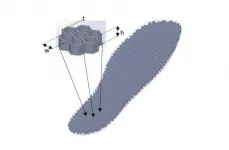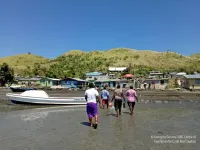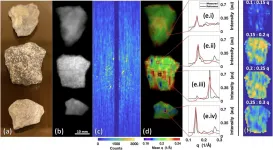(Press-News.org) WASHINGTON--After their initial blast, space rockets shoot away from the Earth with rumbles in infrasound, soundwaves too low to be heard by human ears that can travel thousands of miles.
New research used a system for monitoring nuclear tests to track the infrasound from 1,001 rocket launches. The research identified the distinctive sounds from seven different types of rockets, including the Space Shuttles, Falcon 9 rockets, various Soyuz rockets, the European Space Agency's Ariane 5, Russian Protons and several types of Chinese Long March rockets.
In some cases, like the Space Shuttle and the Falcon 9, the researchers were also able to identify the various stages of the rockets' journey.
https://youtu.be/IfMtEcNkkho
The new information could be useful for finding problems and identifying the atmospheric re-entry or splashdown locations of rocket stages, according to the new study published in Geophysical Research Letters, AGU's journal for high-impact, short-format reports with immediate implications spanning all Earth and space sciences.
Infrasound represents acoustic soundwaves below the general threshold of frequency that humans can hear. But while higher frequency noises are louder close to the source of things like nuclear explosions, low-frequency infrasound travels longer distances. Infrasound is produced by natural events as well as technological sources, and has been used to detect remote volcanic eruptions or the hum of the ocean swell.
To listen in on rocket launches, the authors tapped into a global monitoring network. After the United Nations General Assembly adopted the Comprehensive Nuclear-Test-Ban Treaty in 1996, scientists set up the International Monitoring System (IMS). This system is currently characterized by a series of 53 certified and operational infrasound stations around the world. Micro barometers at the IMS stations can detect the infrasound released by large nuclear explosions.
These stations also gather the infrasonic sounds released by other large explosions such as volcanic eruptions or space rocket launches. The researchers wanted to see if they could detect and characterize the launch of space rockets around the world.
https://youtu.be/prfELKKiciw
They examined 7,637 infrasound signatures recorded at IMS stations from 2009 to mid-2020, a period that included 1,001 rocket launches. The team only examined rocket launches that occurred up to 5,000 kilometers from an IMS station, but found the acoustic signals from rocket launches could sometimes be detected up to 9,000 kilometers away, according to author Patrick Hupe, a researcher at the German Federal Institute for Geosciences and Natural Resources.
The researchers found infrasonic signatures for up to 73% of these rockets, or 733. The other 27% of launches they couldn't detect because the rockets had smaller thrusts or the atmospheric conditions didn't favor the propagation over long distances.
For the ones they did detect, they could determine the type of rockets launched, everything from the Space Shuttles, the last of which launched in 2011, to Russian Soyuz rockets. In total, they examined the signatures for seven rocket types to derive a relation between the measured amplitude and the rocket thrust: Space Shuttles; Falcon 9s; various Soyuz rockets; the European Space Agency's Ariane 5; Russian Protons; Chinese Long March 2Cs, 2Ds, 3As, 4Bs, and 4Cs; and Long March 3Bs.
Space Shuttle vs Falcon 9
The researchers also took a closer look at two different rocket types - the Space Shuttle and the Falcon 9.
They found they could identify the infrasonic signals of various stages of flight for these rockets. For the first, a Space Shuttle launched from Kennedy Space Center in November 2009, the team detected the infrasound created by the splash down of the fuel boosters before they detected the acoustic signal of the initial rocket launch because they dropped down closer to the infrasound station than the launch site. In other words, the rocket was faster than sound.
"The rocket was faster than the infrasound propagated through the atmosphere," Hupe said.
They also examined the launch and descent of SpaceX's Falcon 9 rocket, which has a partially reusable rocket that reentered the atmosphere and landed successfully on a drone ship in the ocean in January 2020. Hupe's team could detect both the takeoff of the rocket and the landing of the first booster.
"By processing the data and also applying different quality criteria to the infrasonic signatures we were able to separate different rocket stages," Hupe said.
"The ability to detect different types of rockets could be helpful," said Adrian Peter, a professor of computer engineering and sciences at the Florida Institute of Technology that wasn't involved in Hupe's work but who has studied the infrasonic signatures of rockets before.
He said the characterization of different stages of rocket launches could be useful for determining future problems. For example, if a rocket didn't launch properly or exploded, researchers might be able to detect what went wrong by analyzing the infrasonic signature, especially when the information is correlated with sensor readings from the rockets themselves.
Peter adds that it's great to see researchers harnessing the information gathered by a monitoring network that was initially only intended to watch for nuclear launches and explosions.
"Now we're leveraging it for other scientific applications," he said, adding that there are likely further uses for this type of data.
INFORMATION:
AGU (http://www.agu.org) supports 130,000 enthusiasts to experts worldwide in Earth and space sciences. Through broad and inclusive partnerships, we advance discovery and solution science that accelerate knowledge and create solutions that are ethical, unbiased and respectful of communities and their values. Our programs include serving as a scholarly publisher, convening virtual and in-person events and providing career support. We live our values in everything we do, such as our net zero energy renovated building in Washington, D.C. and our Ethics and Equity Center, which fosters a diverse and inclusive geoscience community to ensure responsible conduct.
Notes for Journalists:
This research article is open access. Download a PDF copy of the paper here. Neither the paper nor this press release is under embargo.
Paper title:
"1001 Rocket Launches for Space Missions and Their Infrasonic Signature"
Authors:
Christoph Pilger (corresponding author), Patrick Hupe, Peter Gaebler, and Lars Ceranna, Federal Institute for Geosciences and Natural Resources (BGR), Hanover, Germany
Smokers needed their blocked arteries fixed nearly a decade earlier than non-smokers, and patients with obesity underwent these procedures four years earlier than non-obese patients, according to a new statewide study.
The research included patients without a history of heart attack who were treated at hospitals across Michigan participating in BMC2, the Blue Cross Blue Shield of Michigan Cardiovascular Consortium. The patients had undergone angioplasty and/or stenting to widen or unblock their coronary arteries and restore blood flow. Almost all of them had at least one traditional ...
Millions of people with diabetes are at risk of developing foot ulcers, which often lead to amputations and other health complications. Now, Scientists from the Centre for Biomechanics and Rehabilitation Technologies (CRBT) have developed a new method to reliably detect this risk without the need for complex electronic in-shoe sensors.
Dr Panagiotis Chatzistergos, Associate Professor in Orthopaedic Biomechanics, explained: "In the UK alone, 169 people have a toe, foot or limb amputated as a result of diabetes every week, yet importantly up to 80% of these amputations could have been prevented with correct management.
"Routine overloading ...
New research shows what is often assumed to be 'fair' in conservation practice may not be considered so by the very people most affected by it--and a new approach is needed if protected areas are to be effective.
Lead author Dr Georgina Gurney, from the ARC Centre of Excellence for Coral Reef Studies based at James Cook University, said considering local stakeholder conceptions of fairness in conservation is critical.
"If conservation is perceived as unfair it can lead to conflict, undermining support and cooperation," Dr Gurney said.
She said it is not only an ethical matter but key to achieving good ...
University of Illinois Chicago researchers studying birth outcomes in marmoset monkeys found there were no adult maternal characteristics like age or weight gain during pregnancy to predict stillbirth or early neonatal death, but that a mother's birth weight or litter size were associated with early neonatal death.
"Our findings of early life contributions to adult pregnancy outcomes in the common marmoset disrupt mother-blaming narratives of pregnancy outcomes in humans," the paper states.
Julienne Rutherford, associate professor at UIC's School of Nursing, is lead author of "Womb to Womb: Maternal litter size and birth weight but not adult characteristics predict early neonatal death of offspring in the common marmoset monkey" published in the journal PLOS ONE.
Marmosets ...
Since the early days of the COVID-19 pandemic, there were questions about how people in active cancer treatment would fare if they became infected with SARS-CoV-2. The worries were due, in large part, to the effects that cancer and its treatments can have on the immune system. Now that COVID-19 vaccines are widely available, concerns have shifted to the safety and effectiveness of vaccination in this potentially vulnerable population. A study published June 5 in the journal Cancer Cell aims to allay those fears.
In a review of 200 patients with a wide spectrum of cancer diagnoses, researchers at Montefiore Health System and Albert Einstein College of Medicine in the Bronx, NY, found that after full vaccination, 94% of patients overall demonstrated seroconversion, ...
The routes and schedules of public transit, the presence or absence of sidewalks, the availability of different transportation options, and the design of highways that divide cities--these are examples of aspects of transportation systems that can profoundly impact underserved communities' access to basic needs like jobs, health care, education and even food.
A new study by University of Michigan researchers reveals common barriers that transportation decision-makers face in considering these issues and addressing them.
To conduct the study, a team from a multidisciplinary project involving engineering, ...
DARIEN, IL - A study shows that a deep neural network model can accurately predict the brain age of healthy patients based on electroencephalogram data recorded during an overnight sleep study, and EEG-predicted brain age indices display unique characteristics within populations with different diseases.
The study found that the model predicted age with a mean absolute error of only 4.6 years. There was a statistically significant relationship between the Absolute Brain Age Index and: epilepsy and seizure disorders, stroke, elevated markers of sleep-disordered breathing (i.e., apnea-hypopnea index and arousal ...
The widely studied metallic asteroid known as 16 Psyche was long thought to be the exposed iron core of a small planet that failed to form during the earliest days of the solar system. But new University of Arizona-led research suggests that the asteroid might not be as metallic or dense as once thought, and hints at a much different origin story.
Scientists are interested in 16 Psyche because if its presumed origins are true, it would provide an opportunity to study an exposed planetary core up close. NASA is scheduled to launch its Psyche mission in 2022 and arrive at the asteroid in 2026.
UArizona ...
[RALEIGH, N.C.] - How are the squirrels doing this year? The bears? The armadillos? How would you know? A new paper published June 8 sets up the framework for answering these questions across the United States by releasing the data from the first national mammal survey made up of 1,509 motion-activated camera traps from 110 sites located across all 50 states.
Unlike birds, which have multiple large-scale monitoring programs, there has been no standard way to monitor mammal populations at a national scale. To address this challenge, scientists from the North Carolina Museum of Natural Sciences and the Smithsonian Conservation Biology Institute recently collaborated ...
DURHAM, N.C. - Engineers at Duke University have demonstrated a prototype X-ray scanning machine that reveals not just the shape of an object but its molecular composition. With unprecedented resolution and accuracy, the technology could revolutionize a wide range of fields such as cancer surgery, pathology, drug inspection and geology.
Many of the ideas behind the prototype were originally conceived in the pursuit of performing better bomb detection for aviation security. In the new paper, published online May 19 in the journal Scientific Reports, the researchers adapted the technology for several targeted scientific and medical applications.
"Whether you're trying to spot a bomb in a bag or a tumor in a body, the physics is more or less the same," said ...



